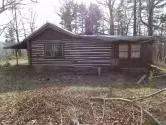To Thomas Wolfe’s Cabin

In 1929, at the naive age of 29, Thomas Wolfe had his first novel published. Now considered one of the masterworks of American 20th century literature, Look Homeward, Angel was a thinly-veiled autobiography of Wolfe’s childhood growing up in Asheville.
His prose was as undisciplined and unfettered as his 6′ 6″ appearance: rough, direct, unruly and uncompromising. His rambling autobiography contains more than 200 characters, nearly all closely modeled after well-known and recognizable citizens of Asheville, whom he often satirized. Not even his brother escaped the swath of Wolfe’s sharpened pencil, describing him as “a pool-room loafer, cheaply and flashily dressed…he would walk down the avenue with a preposterous lurch and a smile of strained assurance… with his lacerated but overgrown vanity….”
Needless to say, the people of Asheville were shocked, angered and disgusted with their native son. His mother, father and siblings, all of whom still lived and worked in Asheville at the time, were saved being drummed out of town only because they were each skewered as deeply as everyone else.
Eight years later, in the summer of 1937, Thomas Wolfe slipped back into Asheville for the first time, unsure of how he would be greeted. Although some still refused to speak to him, the recognition that their community offspring was now considered a successful novelist melted many of their icy opinions.
Unable to concentrate in his childhood home and mother’s boarding house, today preserved as an historic literary landmark in downtown Asheville, Wolfe escaped to a small, solitary log cabin perched high on a wooded knoll overlooking the peaceful Swannanoa River. The 37-year-old writer spent the summer there, working feverishly on what would become, after his tragic death just one year later, his third novel, The Web and the Rock.
I had often encountered references to Thomas Wolfe’s summer cabin, but had never taken the time to track down its whereabouts. Last Sunday, in need of a walk after a hearty meal at one of our favorite Mexican restaurants, Leigh Ann and I set off in search of Wolfe’s literary refuge. Armed only with an address and the knowledge that the cabin was now owned by the city of Asheville, we followed a narrow blacktop road until it became an even narrower gravel road, which then became someone’s private driveway with a large “No Trespassing” sign and a locked gate.
I knew we must be close.
In my younger years I might have turned back, but age has emboldened me, much to the embarrassment of my sons and wife. Leigh Ann was saved the sight of me climbing over a locked gate by the arrival of the owner of the property, who confirmed that, indeed, we were close, but that we would have to hike around her property to get to the cabin.
The weather was balmy, especially for January, and we had come shoed and dressed for a walk, so we locked the car and started up a meandering path leading to the top of the ridge. The modest log cabin was easy to spot, but not so easy to digest. A flapping tarp had been draped over the decaying roof in a feeble attempt to stem the flow of rainwater into the one-story home. Windows had been broken, the porch sagged dangerously, and thorny brambles had taken control of what had once been a rolling lawn, but was now a graveyard for deceased lawnmowers buried in the weeds by city maintenance workers.
I recalled having read that someone hoped the city would transform Wolfe’s cabin into a tourist attraction, but given its remote location and deplorable condition, I knew immediately that would never happen. Besides, as a prudent council member would quickly point out, the city already has a Thomas Wolfe Memorial Visitors’ Center and restored home, both far more accessible than this sagging cabin east of town.
And there really wasn’t much to see once we got there. It was your basic three-room log cabin with a tacked-on kitchen addition that needed to be torn off. Even the view over the Swannanoa River had been compromised by the sight and sounds of semi-trucks pounding their way up Interstate 40 less than a quarter mile away.

Unfortunately, the city will never have enough excess funds to undertake the restoration of this cabin, nor would it consider selling even a portion of the property to a private landowner dedicated to restoring it. The Preservation Society has far more important projects than its membership and financial resources can handle, so the cabin will most likely sit and sag and eventually sink into the ground.
Unless, of course, someone came up with a logical approach and the necessary funds to dismantle the cabin and re-erect it on a more appropriate site….
Anyone in need of a project?
Until next Monday,
Have a great week!
(And see you soon at the Grove Park Inn!)
Bruce
Upper: The cabin as it appears today.
Lower: Tom Wolfe standing in the cabin in 1937, one year prior to his death.
